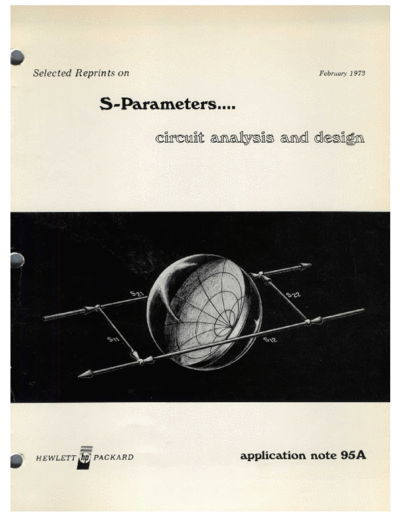Service Manuals, User Guides, Schematic Diagrams or docs for : HP Publikacje an_95-a
<< Back | HomeMost service manuals and schematics are PDF files, so You will need Adobre Acrobat Reader to view : Acrobat Download Some of the files are DjVu format. Readers and resources available here : DjVu Resources
For the compressed files, most common are zip and rar. Please, extract files with Your favorite compression software ( WinZip, WinRAR ... ) before viewing. If a document has multiple parts, You should download all, before extracting.
Good luck. Repair on Your own risk. Make sure You know what You are doing.
Image preview - the first page of the document

>> Download an_95-a documenatation <<
Text preview - extract from the document
Selected Reprints on February 1973
S - Parameters
HEWLETT ihp] PACKARD application note 95A
WHAT ARE "S" PARAMETERS? "S" parameters are measured so easily that obtaining accurate
"S" parameters are reflection and transmission coefficients, phase information is no longer a problem. Measurements like elec-
familiar concepts to RF and microwave designers. Transmission co- trical length or dielectric coefficient can be determined readily from
efficients are commonly called gains or attenuations; reflection co- the phase of a transmission coefficient. Phase is the difference be-
efficients are directly related to VSWR's and impedances. tween only knowing a VSWR and knowing the exact impedance.
Conceptually they are like "h," "y," or "z" parameters because VSWR's have been useful in calculating mismatch uncertainty, but
they describe the inputs and outputs of a black box. The inputs and when components are characterized with "s" parameters there is no
outputs are in terms of power for "s" parameters, while they are mismatch uncertainty. The mismatch error can be precisely calcu-
voltages and currents for "h," "y," and "z" parameters. Using the lated.
convention that "a" is a signal into a port and "b" is a signal out
of a port, the figure below will help to explain "s" parameters.
Easy To Measure
Two-port "s" parameters are easy to measure at high frequencies
TEST DEVICE
because the device under test is terminated in the characteristic
impedance of the measuring system. The characteristic impedance
termination has the following advantages:
1 S,, S 22 ]
S|2
1. The termination is accurate at high frequencies . . . it is
possible to build an accurate characteristic impedance load. "Open"
or "short" terminations are required to determine "h," "y," or "z"
parameters, but lead inductance and capacitance make these termi-
In this figure, "a" and "b" are the square roots of power; (a,)2 is
nations unrealistic at high frequencies.
the power incident at port 1, and (bi)1 is the power leaving port 2.
The diagram shows the relationship between the "s" parameters
2. No tuning is required to terminate a device in the characteristic
and the "a's" and "b's." For example, a signal a, is partially re-
impedance . . . positioning an "open" or "short" at the terminals of
flected at port 1 and the rest of the signal is transmitted through
a test device requires precision tuning. A "short" is placed at the
the device and out of port 2. The fraction of a, that is reflected at
end of a transmission line, and the line length is precisely varied un-
port 1 is s.i, and the fraction of a, that is transmitted is Sn. Simi-
til an "open" or "short" is reflected to the device terminals. On the
larly, the fraction of ai that is reflected at port 2 is s21, and the
other hand, if a characteristic impedance load is placed at the end
fraction s !2 is transmitted.
of the line, the device will see the characteristic impedance regard-
The signal b, leaving port 1 is the sum of the fraction of a, that
less of line length.
was reflected at port 1 and the fraction of a z that was transmitted
from port 2.
Thus, the outputs can be related to the inputs by the equations:
3. Broadband swept frequency measurements are possible . . .
because the device will remain terminated in the characteristic im-
-- SM 3i -f- Su 3i pedance as frequency changes. However, a carefully reflected "open"
Di = 821 3i or "short" will move away from the device terminals as frequency
When a, = 0, and when a, = 0, is changed, and will need to be "tuned-in" at each frequency.
b, b, _^L
SM= -- , sn = -r 3i 4. The termination enhances stability . . . it provides a resistive
Bl
termination that stabilizes many negative resistance devices, which
The setup below shows how s,, and s 2 i are measured.
might otherwise tend to oscillate.
50il TRANSMISSION LINE 50il TRANSMISSION LINE An advantage due to the inherent nature of "s" parameters is:
5. Different devices can be measured with one setup . . . probes
Z SOURCE=50il do not have to be located right at the test device. Requiring probes
50 n
RF SOURCE K TERMINATION to be located at the test device imposes severe limitations on the
setup's ability to adapt to different types of devices.
Port 1 is driven and a^ is made zero by terminating the 50 ft Easy To Use
transmission line coming out of port 2 in its characteristic 50 ft Quicker, more accurate microwave design is possible with "s"
impedance. This termination ensures that none of the transmitted parameters. When a Smith Chart is laid over a polar display of s,,
signal, bi, will be reflected toward the test device. or SH, the input or output impedance is read directly. If a swept-
Similarly, the setup for measuring Su and s◦ Jabse Service Manual Search 2024 ◦ Jabse Pravopis ◦ onTap.bg ◦ Other service manual resources online : Fixya ◦ eServiceinfo